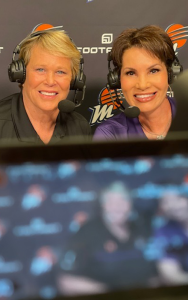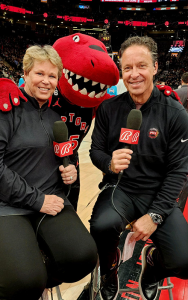
Ann Meyers Drysdale, left, and Cindy Brunson are trailblazers helping to change the makeup of the broadcast industry while inspiring the next generation of women. (Photo courtesy of Ann Meyers Drysdale)
PHOENIX – It’s been two years since women ruled the court. On March 24, 2021, during an NBA game between the Denver Nuggets and the Toronto Raptors, women controlled every single on-air role of the national broadcast. The play-by-play, color analysis, sideline reporting, as well as the pregame, postgame and halftime show were all led by women.
This particular event appeared to be a game-changer for women in the sports broadcasting industry. But it’s not as if one monumental night completely altered decades of policies rooted in tradition and, sometimes, sexism.
“It’s been a man’s world. And it still is, but slowly but surely, the women are breaking in and in different positions,” said Ann Meyers Drysdale, the vice president of the Phoenix Suns and Mercury, as well as the color analyst for both teams.
The Civil Rights Act of 1964 and Title IX were approved after the NBA’s inception in 1946, yet it took decades for something like this to happen. According to Zippia.com, men held 83.5% of sports broadcasting jobs in 2022. Since that ground-breaking game the previous year, women continue to grasp the opportunity to narrow the gap.
Meyers Drysdale has witnessed the evolution of women in sports broadcasting. While Meyers Drysdale played for UCLA’s women’s basketball team, she participated in some broadcasting classes throughout her four years at the university. When she wasn’t gracing the hardwood, she was approached about doing games for the team on national television, since the team was in Los Angeles.
After her time with the Bruins, she signed with the Indiana Pacers, becoming the first woman to sign with an NBA team as a free agent. Her knowledge of the game superseded any doubt of her being able to broadcast a game. However, Meyers Drysdale endured a test in the City of Angels.

Cindy Brunson, formerly of ESPN, works as the play-by-play voice for the Phoenix Mercury. (Photo courtesy of Cindy Brunson)
The 1984 Olympics in Los Angeles marked the first time women’s basketball was being broadcast. ABC play-by-play voice Keith Jackson had practice runs before calling the game with Meyers Drysdale. According to Meyers Drysdale, Jackson stopped in the middle of their practice run to tell the producers to let her speak, as they wanted Jackson to speak the entire time. That moment in time presented her with the respect she knew she deserved.
“Keith was strong enough to understand that whether as a woman or not I was the analyst and wanted to hear that voice. There were times where I think the majority of the time, I don’t know whether because I was a woman or not, that I was well respected for my opinion and knowledge of the game,” Meyers Drysdale said.
“The people that I worked with the majority of the time were like, ‘Yes, we want to hear from you and your voice is important.’ So I feel very confident that I’ve been respected in the game.”
Qualifications are such an important characteristic of broadcasting and Mercury play-by-play voice Cindy Brunson has plenty of them. The Washington State alum anchored for ESPN and anchors for the Pac-12 network and for Athletes Unlimited Basketball alongside WNBA Hall-of-Famer Sheryl Swoopes. Brunson spoke about why the decision to put women in these positions remains stagnant.
“Oh, that’s an easy answer. There are a lot of older white males making the hiring decisions. Until we get people in the room who look like us, who can say, ‘Hey, that’s a good idea’, or folks who are a little more hip to how things could look and have different ideas,” Brunson said. “Until you get into those rooms or folks like myself get into those rooms, making those decisions to change really isn’t going to happen.”
Brunson isn’t wrong about the lack of diversity within organizations. A 2022 report by the Journal of Accountancy stated that 88.8% of CEOs, CFOs and COOs are Caucasian, and 88.1% of those are men. Meyers Drysdale broke the invisible barrier as she was the Mercury general manager in 2007 and had an all-women’s leadership team around her. She replaced the suit with a headset and before the 2022 Mercury season tipped off, Brunson worked with her hero, Meyers Drysdale. This moment came full circle for the former ESPN anchor and fulfilled a lifelong dream.
“She’s just amazing and she knows more about basketball than I could ever hope to learn. She has a breadth of knowledge that I can never hope to achieve. But saying that, she couldn’t be more warm, more welcoming, more helpful, a great teammate and that’s what you look for in a broadcast partner. It was really a dream come true scenario for me at the broadcast table,” Brunson said.

Ann Meyers Drysdale, left, sees progress since the first all-women’s broadcast aired in 2021 but says “it shouldn’t be that big a deal” due to the countless qualified candidates for prominent television roles. (Photo courtesy of Ann Meyers Drysdale)
While Brunson drew inspiration from the former UCLA star to start her own broadcasting career, others now look to Brunson for the same. During the COVID-19 pandemic, events came full circle for Brunson. She described what it means for not only women, but people of color to keep moving forward in sports broadcasting.
“I found out that not only was I having an impact on the lives of young women, which I have always strived to do, but I didn’t realize my impact on those that have black and brown skin, both male and female,” Brunson said. “Every time I take a job now, even with the Phoenix Mercury, I’m driving down the highway of life on my little career and I know that I’ve got black and brown people in the back seat behind me, and I’m taking them with me.”
Jody Jackson is another seasoned Arizona veteran in the business. She worked as a radio host in Miami before switching to TV in Buffalo and eventually moved to Phoenix as a host and reporter for what was then Fox Sports Arizona. Jackson luckily never experienced any of the repercussions of being a woman in the industry. Now with Bally’s Sports Arizona, Jackson has found a way to give back to young women who aspire to be in her position one day.
“Since the beginning of my career, early on, I was asked by a lot of young people, ‘Hey, can I come out and see work? Can I shadow you?’ And I’ve always said yes to that,” Jackson said. “You have to have a lot of belief in yourself and trust yourself, but I hope that I’ve shown that to people along the way. I hope a lot of women have benefited from just coming out and seeing that experience firsthand.”
Mercury forward Sophie Cunningham is part of the next generation of sports broadcasters. As the 13th overall pick in the 2019 WNBA draft and a University of Missouri standout, the 3-point sniper found a niche off the court with broadcasting. In December 2022, she joined the Suns’ broadcast team for home games as a guest analyst on the pregame, postgame and halftime shows. Cunningham is well aware of the impact seeing somebody like her in a broadcasting role has on young women.
“I think it’s important for young girls to see people like them in a position where normally it’s men and I think there’s a lot of companies, especially the Mercury and the Suns, (who) want to see us women be in those positions,” Cunningham said. “I think it’s a big push in American culture right now to empower women. I think that it’s important, especially for young girls all around the country to see people who look like them in those types of situations.”
That empowerment of women is tangible, especially as voices like Lisa Byington of the Milwaukee Bucks and Kate Scott of the Philadelphia 76ers take the reigns. Meyers Drysdale is no stranger to history’s sometimes glacial progress as she and ESPN anchor Hannah Storm were the first two women to call the first WNBA game in 1997. When asked about the first all-women’s NBA broadcast in 2021, Meyers Drysdale wasn’t surprised that a moment of this magnitude took place.
“I’m so proud of all the women that were involved in that NBA game, but it shouldn’t be that big a deal. Quite honestly, they’re all qualified,” Meyers Drysdale said. “All of them should be calling games all the time and in working games on the camera, producing and graphics and so forth. So to me, it’s about if they’re qualified. It shouldn’t matter about their gender.”
